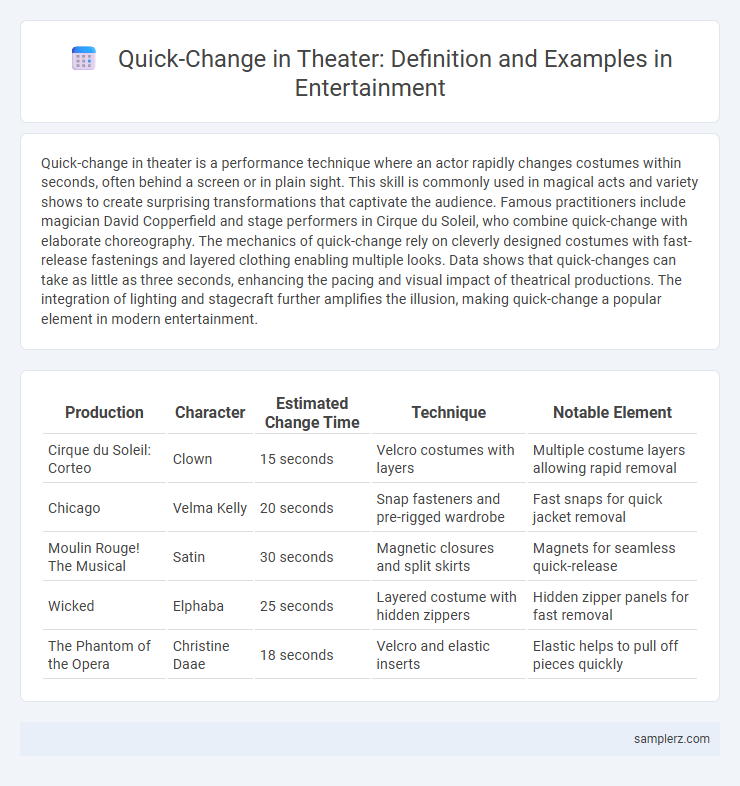Quick-change in theater is a performance technique where an actor rapidly changes costumes within seconds, often behind a screen or in plain sight. This skill is commonly used in magical acts and variety shows to create surprising transformations that captivate the audience. Famous practitioners include magician David Copperfield and stage performers in Cirque du Soleil, who combine quick-change with elaborate choreography. The mechanics of quick-change rely on cleverly designed costumes with fast-release fastenings and layered clothing enabling multiple looks. Data shows that quick-changes can take as little as three seconds, enhancing the pacing and visual impact of theatrical productions. The integration of lighting and stagecraft further amplifies the illusion, making quick-change a popular element in modern entertainment.
Table of Comparison
| Production | Character | Estimated Change Time | Technique | Notable Element |
|---|---|---|---|---|
| Cirque du Soleil: Corteo | Clown | 15 seconds | Velcro costumes with layers | Multiple costume layers allowing rapid removal |
| Chicago | Velma Kelly | 20 seconds | Snap fasteners and pre-rigged wardrobe | Fast snaps for quick jacket removal |
| Moulin Rouge! The Musical | Satin | 30 seconds | Magnetic closures and split skirts | Magnets for seamless quick-release |
| Wicked | Elphaba | 25 seconds | Layered costume with hidden zippers | Hidden zipper panels for fast removal |
| The Phantom of the Opera | Christine Daae | 18 seconds | Velcro and elastic inserts | Elastic helps to pull off pieces quickly |
Defining Quick-Change in Theater
Quick-change in theater refers to the rapid costume transformation performed by actors during a live performance, often within seconds backstage or in full view of the audience. This technique demands precise choreography, expert wardrobe designs, and seamless coordination between performers and dressers to maintain the flow of the narrative. The art of quick-change enhances theatrical storytelling by enabling dynamic character shifts and sustaining audience engagement without lengthy intermissions.
Iconic Quick-Change Performances on Stage
Iconic quick-change performances in theater showcase actors transforming costumes in seconds, captivating audiences with seamless transitions that enhance storytelling and visual spectacle. The legendary performances by companies like Le Grand Cirque and artists such as Arturo Brachetti highlight the mastery of quick-change artistry, blending rapid costume alterations with precise choreography. These acts not only exemplify technical skill but also add dynamic energy that elevates the theatrical experience.
Essential Techniques for Quick Costume Changes
Mastering essential techniques for quick costume changes in theater involves precise choreography, effective use of fasteners like Velcro and magnetic snaps, and strategic costume layering. Performers rely on tabbed garments and pre-stitched seams to minimize time offstage, enhancing seamless transitions between scenes. Efficient backstage coordination and rehearsed timing further ensure swift changes without disrupting the flow of the performance.
Famous Shows Featuring Quick-Change Moments
Famous shows featuring quick-change moments include "The Phantom of the Opera," where characters switch elaborate costumes within seconds onstage, showcasing seamless transformations that captivate audiences. Broadway hits like "Sweeney Todd" and "Zorro" also highlight rapid costume changes integral to storytelling and character development. These quick-changes demonstrate exceptional costume design and stagecraft, enhancing theatrical immersion and excitement.
Behind-the-Scenes: How Quick-Change Works
Quick-change in theater involves performers rapidly switching costumes within seconds, often using layered outfits and magnetic closures to accelerate the process. Behind-the-scenes teams coordinate timing, lighting, and props to ensure seamless transitions that maintain the illusion for the audience. Specialized training and meticulously designed costumes allow actors to execute quick-changes flawlessly, enhancing the spectacle without interrupting the narrative flow.
Quick-Change Magicians Versus Theater Artists
Quick-change magicians specialize in stunning costume transformations within seconds, leveraging precise choreography and hidden mechanisms to captivate live audiences with rapid visual effects. Theater artists employ quick-change techniques to seamlessly shift characters and scenes, integrating costume changes as a narrative tool to enhance storytelling and maintain dramatic flow. The contrast lies in magicians' emphasis on speed and surprise, while theater artists prioritize fluidity and character development through quick-change artistry.
Memorable Quick-Change Acts in Musicals
Memorable quick-change acts in musicals captivate audiences with their seamless costume transformations that demonstrate exceptional precision and creativity. Productions like "The Rocky Horror Picture Show" and "The Phantom of the Opera" showcase rapid outfit shifts that enhance dramatic effect and storytelling. These quick-change moments rely on expertly engineered costumes and skilled performers to maintain the musical's energetic pacing and visual spectacle.
Innovative Costume Designs for Fast Changes
Innovative costume designs for fast changes in theater showcase modular elements, such as detachable sleeves and magnetic closures, enabling actors to transform characters swiftly without backstage delays. Lightweight fabrics combined with layered garments allow seamless transitions that maintain character continuity and visual impact. These advancements enhance production fluidity while preserving artistic integrity in dynamic live performances.
Challenges Actors Face with Quick-Change Scenes
Quick-change scenes in theater demand actors to master rapid costume transformations, often within seconds, intensifying physical and mental pressure. The challenges include memorizing complex costume sequences, maintaining character continuity, and managing breath control amidst fast-paced backstage chaos. These moments require seamless coordination between actors and wardrobe teams to ensure flawless transitions that uphold the production's flow and audience immersion.
Audience Reactions to Impressive Quick-Changes
Audiences often respond with astonishment and applause when actors execute swift costume transformations during live performances, enhancing the theatrical experience. These impressive quick-changes showcase the performers' agility and backstage coordination, leaving spectators captivated by the seamless magic on stage. Such moments create memorable highlights that elevate the overall impact of the production.

example of quick-change in theater Infographic
 samplerz.com
samplerz.com